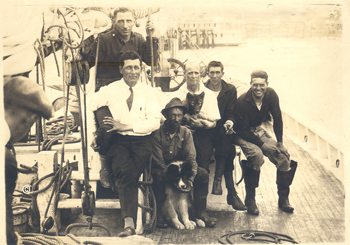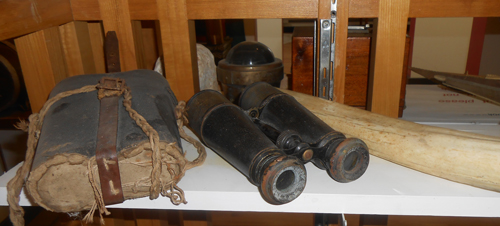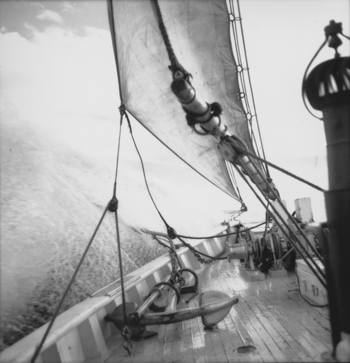The MacMillan Voyages
on the Schooner Bowdoin
by Tom Seymour

Captain Donald MacMillan, holding a sled dog puppy, and some of his crew were photographed on the deck of the schooner Bowdoin, upon their return home in 1922. The Bowdoin was a research vessel specially designed by MacMillan for sailing the arctic. This trip had been the Bowdoin’s first voyage. Just right of MacMillan, holding a cigar, was that voyage’s ship engineer, Harold Whitehouse. Whitehouse had also been the engine man at Hodgdon Brothers shipyard, where the Bowdoin was built from 1920-1921. Photo courtesy of The Peary-MacMillan Arctic Museum, Bowdoin College
Arctic explorer Donald MacMillan was a man of superlatives. Among other firsts, his was the first wireless radio transmission from above the Arctic Circle. This was during his 1923-34 expedition to the arctic. Previous to that, during his 1921-22 expedition, his radio failed because of interference from the aurora. But the second expedition was equipped with a “shortwave” radio, a new, more efficient invention.
Another MacMillan first was the use of a smaller, specially built vessel for arctic exploration. The heavier boats used for arctic exploring had problems galore, including the lack of ability to carry enough fuel for their engines. Also, being large, they could not maneuver well in cramped, icebound, open-water lanes. MacMillan envisioned smaller, very maneuverable vessel, strongly built and designed to handle the rigors of arctic waters. Out of this came the schooner Bowdoin, built in East Boothbay, Maine, in 1921. The Bowdoin was 88-feet long, 21 feet wide and weighs 60 tons. She was double-planked and double-framed of sturdy, white oak. Her rudder was extra-large for swift turning in narrow belts of open water. Her bow was capped with a 1,800-pound steel nosepiece, designed for ramming ice and mitigating blows from ice flows.
The Bowdoin was a sailing vessel with a small engine and large fuel storage capacity. This, it seemed to MacMillan, was the perfect combination for arctic travel. And he was right. In all, the Bowdoin made 26 voyages above the Arctic Circle.
Yankee Ingenuity
The Bowdoin, during her 1921-22 maiden voyage to northern Greenland, spent the winter locked in ice. This was expected. But when summer came and the anticipated thaw was less effective at melting ice than hoped, it appeared that the Bowdoin would be icebound for yet another year.
However, the little schooner was engineered for just such trying circumstances. Having been locked in ice for 335 days, everyone on the vessel was anxious to head home. So MacMillan attempted to hurry the thaw by sprinkling coals and cinders from the Bowdoin on the ice. This new cover of black captured warmth from the sun, helping to melt the ice.
This all happened in September and MacMillan knew too well that another arctic winter was just around the corner. So deciding that his coal-and-cinder applications must have had at least some effect, he started the Bowdoin’s engine and broke free from this enforced confinement.
But the Bowdoin and her crew were not out of the woods yet. Once in open water, the vessel went aground. The crew was able to free her, though. Once clear, MacMillan saw that the only passage to the open ocean was blocked by a 6,000,000-ton iceberg.
Again, the design and unique ability of the Bowdoin paid off. The part of the iceberg blocking the narrow passage to freedom was long and somewhat fragile-looking. MacMillan decided to ram this, hopefully, susceptible part of the berg. This attempt was successful. The Bowdoin sailed through the narrow harbor exit and immediately after she reached safety, the iceberg swung around, completely blocking the channel.
Were it not for these extraordinary maneuvers, the Bowdoin may have spent an undetermined time in icy confinement.

MacMillan’s Bowdoin binoculars and case now at the
Sail, Power and Steam Museum in Rockland, Maine.
Tom Seymour photo
Arctic Life
Living on ice in the frozen arctic was nothing new to Donald MacMillan. He was a modern master of arctic life. Back in 1909, while accompanying Robert Peary on the quest for the North Pole, MacMillan became unable to travel further because of frozen feet.
Peary had no choice but to leave MacMillan, assuring him that he would pick him up upon his return from the pole. MacMillan had food enough to survive, plus a Trapdoor Springfield, single-shot carbine that Peary left him for protection against marauding polar bears.
True to his word, Peary found and rescued MacMillan on his return from the pole. The gun that MacMillan used when stranded, alone on the top of the world, is currently on exhibition at the Sail, Power & Steam Museum in Rockland, Maine.
A photo of the Bowdoin locked in ice reveals igloos atop each hatch. These provided some protection from the elements, but their primary function was to keep polar bears out. MacMillan, being experienced in the ways of the great white bear, knew well the advantages of being proactive regarding these huge predators.
Drinking water was another necessity, something that people in temperate climes take for granted. But when icebound somewhere north of Greenland, any water contained in barrels during the trip to the north had either run out or had become stagnant. But good, clean water was always at hand. This water, in fact, was ancient and unpolluted. The water came from ice chipped from icebergs and melted on the ship’s stove and stored in wooden casks.
Special axes were used to chip ice for the crew on the Bowdoin. One example of this graces a wall in the Sail, Power & Steam Museum, in the room containing so many other MacMillan artifacts.
Ice goggles were something else that MacMillan knew was necessary to arctic survival. These were not the dark-tinted, polarized glasses of today. Rather, MacMillan used goggles manufactured by the Inuit. These were something like goggle-style blinders with a small slit in the center of each goggle. The eye could see out at least well enough to function, but the sun’s harmful ultraviolet rays were effectively blocked.

Navigating the Strait of Belle Isle, which runs between Labrador and Newfoundland, can be tricky at the best of times. Rough seas and sea ice are common for much of each year, as is bad weather ranging from thick fog to outright gales. Also known as the Labrador Straits, this passage was an essential route to and from the schooner Bowdoin’s Arctic destinations. The schooner was built to tackle tough conditions. Photo courtesy of The Peary-MacMillan Arctic Museum, Bowdoin College
Native Language
In 1929, Donald MacMillan built the Nain, Labrador school, which was run by Moravians. The Moravians were the first Protestant denomination, founded in the early 1400s. MacMillan put much time and capital into this school for Inuit (Eskimo) children. The people from the school, both Inuit and Moravian, held MacMillan in such high esteem that they gave him a copy of the Moravian bible, written in the Inuit tongue. This bible resides in the MacMillan room in the Sail, Power & Steam Museum.
The school was eventually turned over to the Lutheran Church after the Moravians left. But it was Donald MacMillan who envisioned a school and who got it built and up and running.
MacMillan is also credited with an Inuit language dictionary. This, too, is an offshoot of his love for these people.
The MacMillan voyages on the schooner Bowdoin were made strictly for the advancement of knowledge and for gaining new insight into the arctic region and the animals and people who lived there. The various voyages included onboard, botanists, aviators, sailors and scientists of all kinds. MacMillan’s landmark use of amphibious aircraft (under the most trying conditions) and the Loening airframe and the inverted Liberty engine led to the beginning of the end of arctic explorers trekking across frozen wastelands and the beginning of mechanized exploration.
And all this was made possible by the 88-foot, specially built schooner Bowdoin, along with the courage and foresight of her master, Admiral Donald MacMillan.
Admiral MacMillan sold the Bowdoin to the U.S. Navy for use during World War II. And today, the Bowdoin sits on her mooring in Castine, Maine, proudly cared for by the Maine Maritime Academy.
The Bowdoin still makes training voyages to the frozen north, which is exactly what she was built for. It would please Donald MacMillan to know that. He died in 1974 at age 96.
Many thanks to the Sail, Power & Steam Museum for photographs and information on the MacMillan artifacts.
